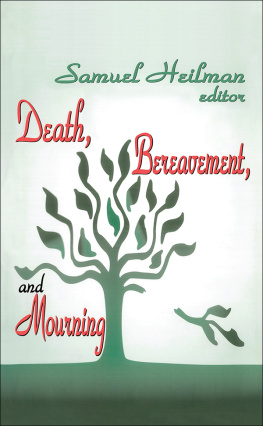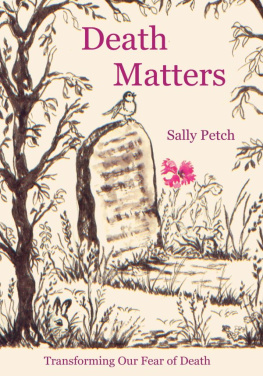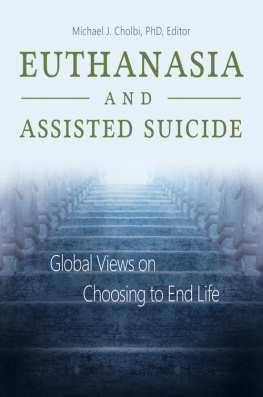Death, Grief, and
Mourning
Individual and Social Realities
John S. Stephenson

THE FREE PRESS
A Division of Macmillan, Inc.
NEW YORK
Collier Macmillan Publishers
LONDON
Copyright 1985 by John S. Stephenson
All rights reserved. No part of this book may be reproduced or transmitted in any form or by any means, electronic or mechanical, including photocopying, recording, or by any information storage and retrieval system, without permission in writing from the Publisher.
The Free Press
A Division of Macmillan, Inc.
866 Third Avenue, New York, N.Y. 10022
www.SimonandSchuster.com
Collier Macmillan Canada, Inc.
Printed in the United States of America
printing number
1 2 3 4 5 6 7 8 9 10
Library of Congress Cataloging in Publication Data
Stephenson, John S. (John Samuel)
Death, grief, and mourning.
Bibliography: p.
Includes index.
1. DeathUnited StatesPsychological aspects.
2. DeathSocial aspectsUnited States.
3. BereavementPsychological aspects.
I. Title.
BF789.D4S735 1985 306.9 85-1571
ISBN 0-02-931330-9
ISBN:13 978-0-0293-1330-5
eISBN:13 978-1-4391-3718-5
For Johnny
Still with his eyes on the world Christopher Robin put out a hand and felt for Poohs paw.
Pooh, said Christopher Robin earnestly, if Iif Im not quite he stopped and tried againPooh, whatever happens, you will understand, wont you?
Understand what?
Oh, nothing. He laughed and jumped to his feet. Come on!
Where? said Pooh.
Anywhere, said Christopher Robin.
A. A. Milne
Contents
Preface
THE INTERDISCIPLINARY NATURE of this book grew as much out of the demands of the subject matter as the authors biases. A topic as broad as death is best understood in the light of studies in many disciplines. History provides an understanding of the roots of many of our contemporary behaviors and attitudes. Sociology is valuable when examining our contemporary institutions and behavior, and psychology aids in understanding individual responses to death. One of my primary objectives has been to unite these perspectives in a framework within which the many dimensions of death and dying may be viewed, and the relations between them explored.
Central to the books theoretical perspective is the concept of the imagethat inner schema through which we understand and act in the world. The image of death that people held in earlier times affected the ways in which they felt and acted, as we see when we examine the history of American attitudes and behaviors surrounding death. Our contemporary social response to death is an institutional one; death is relegated to the hospital, hospice, and nursing home. These institutions reflect the larger collective image as they function to respond to death. Socially valued people are treated differently from the less socially desirable. Individual behavior does not take place in a vacuum; it takes place within a social context which both affects the persons actions and is in turn affected by those actions.
Griefthe individuals response to lossis a function of the individuals as well as the larger societys understanding of the loss. Neither a strictly sociological nor psychological explanation will allow us to fully understand grief; it is necessary to take into account both the person and the social environment in order to understand why the grief-stricken behave and feel as they do. We will also examine the effects of grieving upon various categories of people such as the widowed and the family unit.
The ceremonies of death are discussed for several reasons. They not only serve as a collective response; they also manifest the collective image of deathwhat the larger society thinks and feels about death. In examining suicide, I provide an explanation congruent with the books overall theoretical perspective. Suicide is a topic which fascinates many in the field of thanatology, which is a more formal title for the field of death and dying. It is fascinating in that the very act itself is often shrouded in mystery, and it is seemingly contrary to the vital image of existence which most people cherish. We will see that the suicidal act is influenced by the social context within which it takes place. Euthanasia, the subject of the final chapter, is an issue which, while intensely personal (in dealing with the termination of a persons existence), also reflects the image of death in the larger society.
This book looks at death, dying, and bereavement from within the context of the American experience. The American image of death is a unique one, as is the image of death in any society. Obviously, we cannot generalize from this study to other societies. It is not possible within the parameters of this book to thoroughly examine the entire range of cultural variations in the depth to which the American image is examined.
CHAPTER ONE
Death:
A Theoretical Perspective
THROUGHOUT THE HISTORY of humanity, and even in prehistoric times, people have sought to give meaning to death. The evidence of this surrounds us, whether it be an army of statues created to protect a Chinese emperor, the pyramids of Egypt, or the Tomb of the Unknown Soldier. All of these are statements about death, and the meaning that it has for people. Death is an event that everyone knows about, but about which little is known. We do know that at one point life as we know it ceases to be. Beyond that, we know little except what is told to us by seers, mystics, prophets, and those who claim to have returned from the dead. From the time that humanity first became aware, people have had to grapple with the question of their mortality. They have answered that question in many different ways, usually in response to many different experiences and reasonings. But the quest has always been therethe search for an answer to the question, Why was I born, if just to die?
To live and then die meaninglessly is a terrible fate. And so humanity struggles to find an answer which will make sense of existence. Why death? is and has been a fundamental question for all people. Answers to this question become infused in cultures and are passed on to succeeding generations. Most cultures are blendings of many different rationales and explanations of death, which means that the value and meaning of death within a particular culture may be many-faceted.
In American society, which will be the focus of this book, death has many meanings. It may mean that one is to dwell in heaven or hell. To some, death is a state of nothingness. To others, death is a transitory state until one returns in another life or life form. These are some of the various explanations for the state of being dead. Being dead is very different from dying, which is a process of living.
The way in which one dies is an important part of death, and so it has its own meanings. For example in America, altruistic suicidewhere one gives his or her life for anotheris highly valued. Taking your life in the face of a painful and lingering fatal illness is not seen as a good act. Thousands of dollars will be spent by the state to keep a suicidal prison inmate alive, so that the state can then carry out the capital punishment verdict and kill him or her. The federal government will devote great energies to save the lone sailor and his foundering boat caught in a storm at sea; and at the same time support the toxic tobacco industry through large subsidies. In American society, a high number of automobile deaths is acceptable; a high number of crib deaths is not.








